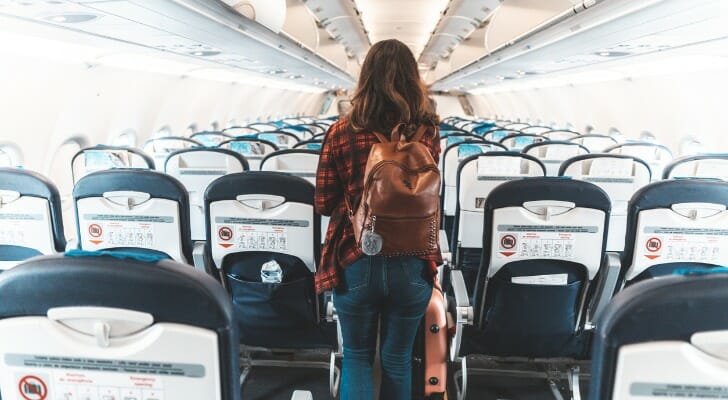 In late April 2020, the Treasury Department concluded agreements with several U.S. airlines and began to make initial payments of the Payroll Support Program, a provision established in the Coronavirus Aid, Relief and Economic Security (CARES) Act that intends to support the hard-hit aviation industry after the grounding effects of the onset of the coronavirus crisis.
In late April 2020, the Treasury Department concluded agreements with several U.S. airlines and began to make initial payments of the Payroll Support Program, a provision established in the Coronavirus Aid, Relief and Economic Security (CARES) Act that intends to support the hard-hit aviation industry after the grounding effects of the onset of the coronavirus crisis.
Who Will Receive the Airline Bailout?
Most recently, as of May 12, the Treasury Department distributed upwards of $25 billion in assistance to 352 approved applicants, including all of the major passenger air carriers, more than 260 smaller passenger air carriers and a significant number of cargo air carriers and contractors. According to the Treasury website, this funding will support hundreds of thousands of American jobs.
Among the first companies to receive assistance on April 20 were Allegiant Air, American Airlines, Delta Air Lines, Southwest Airlines, Spirit Airlines and United Airlines.
According to April 27 data, American Airlines received the highest amount of total anticipated payroll support, at roughly $5.81 billion. Following that was Delta Air Lines at $5.44 billion, United Airlines at $4.96 billion, Southwest Airlines at $3.26 billion and Alaska Airlines at $9.92 million. You can find the full list of Payroll Support Program participants here.
How Will Airlines Receive Funding Through the Payroll Support Program?
This assistance is part of the more than $50 billion in aid that U.S. legislators doled out to the aviation industry as part of the CARES Act passed in March, which provided a total of $2 trillion in economic relief funding.
Payments take the form of either payroll grants or loans, both of which come with some caveats. All funds provided via the Payroll Support Program are allowed only for the continuation of payment of employee wages, salaries and benefits. According data on from the Treasury website as of April 27, the breakdown of payroll support is as follows:
- a total of up to $25 billion available for passenger air carriers
- up to $4 billion available for cargo air carriers
- up to $3 billion available for certain contractors
Airlines must agree that they will not furlough workers through September 30 of this year. Furthermore, they must maintain certain levels of service as far into the future as 2022 and must also maintain certain limits on stock buybacks and executive compensation.
The CARES Act specifies that each air carrier or contractor can receive an amount (which may be prorated) based on part of last year’s payroll expenses (April 2019 through September 2019). Additionally, certain Payroll Support Program participants may need to provide financial documentation in order to receive aid. This includes:
- passenger air carriers receiving payroll support of more than $100 million
- cargo air carriers receiving support of more than $50 million
- eligible contractors receiving more than $37.50 million
Any participant who receives payroll support of more than $100 million is required to provide documentation to the government stating that it would pay back the loan portion of its assistance over a 10-year period. It must also provide the Treasury with stock warrants. A stock warrant allows its holder to buy stock at a guaranteed price until the warrant is no longer valid.
Immediate Effects and Future Uncertainty
Both the increasing health, safety and financial risks that have come as a result of the COVID-19 pandemic mean that travel and plane ticket purchases will be limited for the foreseeable future. Despite this, however, one of the benefits of the Payroll Support Program is that it keeps the industry’s frontline workers – including mechanics, pilots and flight attendants – on the job.
“The Payroll Support Program is successfully supporting American workers and preserving our vital aviation industry,” said Secretary Steven T. Mnuchin in a statement on the Treasury website. “Treasury is committed to the highest standards of public transparency as we provide this critical relief.”
However, with the industry not expected to bounce back to pre-coronavirus levels anytime soon – it may take at least a couple of years to reach a new normal – it is unclear what will happen when this support runs out. Looking to the future, many carriers are offering incentives to employees who decide on early retirement. Some others have even encouraged current workers to take voluntary furloughs.
Tips for Managing Unemployment or a Struggling Business
- If you did lose your job, learn if you qualify for enhanced unemployment. Many unemployment benefits across states have been expanded as a result of the spread of coronavirus. Our guide on the Enhanced Unemployment Benefits for Coronavirus can help you figure out if you may be eligible for receiving a benefit and how much that benefit will be.
- COVID-19 help is available for small business owners. The government is doing a lot to help small businesses – and the individuals who work for them – through the economic downturn. See what your options are here, and make sure to take advantage of any that apply to you.
- Consider talking to a financial advisor about how to ride out a financial downturn. Finding the right financial advisor that fits your needs doesn’t have to be hard. SmartAsset’s free tool matches you with financial advisors in your area in 5 minutes. If you’re ready to be matched with local advisors that will help you achieve your financial goals, get started now.
Photo credit: ©iStock.com/MesquitaFMS